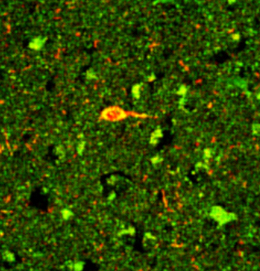NAGRODA KONORSKIEGO DLA PUBLIKACJI Z INSTYTUTU NENCKIEGO
 Konorski Awards Committee, appointed by the Committee of Polish Academy of Neurobiology and the Polish Neuroscience Society represented by prof. Leszek Kaczmarek, prof. Bartosz Karaszewski, prof. Urszula Sławińska, prof. Maria Stankiewicz, prof. Joanna Lewin-Kowalik, prof. Marian H. Lewandowski (Chairman) awarded the prize for the best publication Calcyclin binding protein and Siah-1 interacting protein in Alzheimer's disease pathology: neuronal localization and possible function, published in Neurobiology of Aging 34 (2013) 1380-1388 by authors: Urszula Wasik, Gabriela Schneider, Anna Mietelska-Porowska, Marcin Mazurkiewicz, Hanna Fabczak, Serge Weis, Claudia Zabke, Charles R. Harrington, Anna Filipek and Grazyna Niewiadomska.
Konorski Awards Committee, appointed by the Committee of Polish Academy of Neurobiology and the Polish Neuroscience Society represented by prof. Leszek Kaczmarek, prof. Bartosz Karaszewski, prof. Urszula Sławińska, prof. Maria Stankiewicz, prof. Joanna Lewin-Kowalik, prof. Marian H. Lewandowski (Chairman) awarded the prize for the best publication Calcyclin binding protein and Siah-1 interacting protein in Alzheimer's disease pathology: neuronal localization and possible function, published in Neurobiology of Aging 34 (2013) 1380-1388 by authors: Urszula Wasik, Gabriela Schneider, Anna Mietelska-Porowska, Marcin Mazurkiewicz, Hanna Fabczak, Serge Weis, Claudia Zabke, Charles R. Harrington, Anna Filipek and Grazyna Niewiadomska.
In this work we have studied the role of CacyBP/SIP in Alzheimer’s disease which belongs to a group of neurodegenerative diseases collectively designated as ‘‘tauopathies’’. They are characterized by the aggregation of abnormally phosphorylated tau protein which leads to formation of PHFs (paired helical filaments) or NFTs (neurofibrillary tangles) and in consequence, cause the pathology. The CacyBP/SIP protein is highly expressed in brain and its interaction with tubulin suggested involvement of this protein in cytoskeletal reorganization which is important in many cellular processes occurring during neurodegeneration. In this work we have shown, using brain tissue from Alzheimer disease (AD) patients and from transgenic mice modeling human tauopathy, that CacyBP/SIP co-localizes with PHF in neurons of AD brains and exhibits similar subcellular localization as tau protein in neurons of tauopathic mice brains. Moreover, our results have shown for the first time that CacyBP/SIP might dephosphorylate tau protein. This finding seems to be important in future studies concerning the understanding of molecular mechanisms leading to AD pathology.
